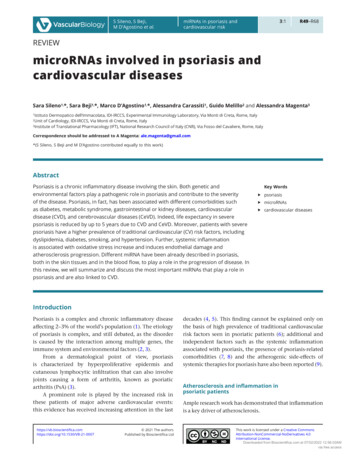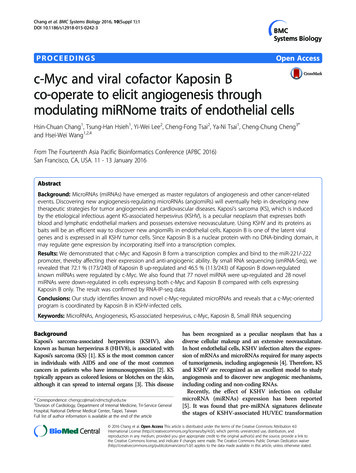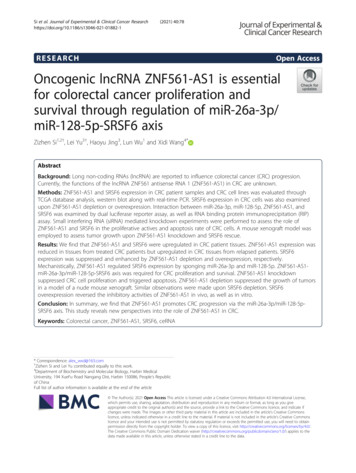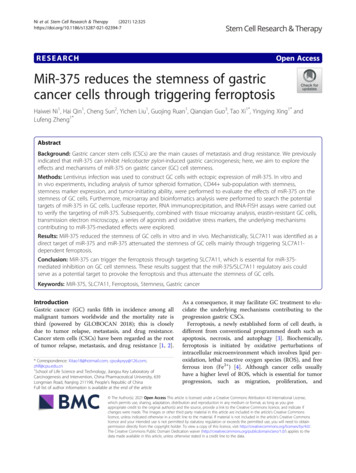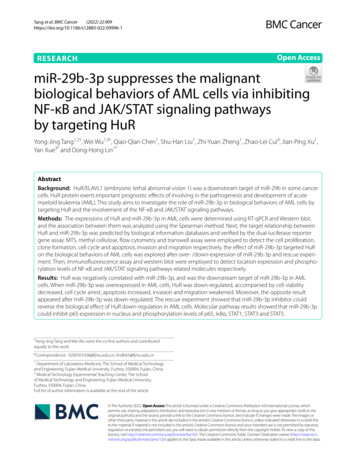
Transcription
(2022) 22:909Tang et al. BMC en AccessRESEARCHmiR‑29b‑3p suppresses the malignantbiological behaviors of AML cells via inhibitingNF‑κB and JAK/STAT signaling pathwaysby targeting HuRYong‑Jing Tang1,2†, Wei Wu1,3†, Qiao‑Qian Chen1, Shu‑Han Liu1, Zhi‑Yuan Zheng1, Zhao‑Lei Cui4, Jian‑Ping Xu1,Yan Xue3* and Dong‑Hong Lin1*AbstractBackground: HuR/ELAVL1 (embryonic lethal abnormal vision 1) was a downstream target of miR-29b in some cancercells. HuR protein exerts important prognostic effects of involving in the pathogenesis and development of acutemyeloid leukemia (AML). This study aims to investigate the role of miR-29b-3p in biological behaviors of AML cells bytargeting HuR and the involvement of the NF-κB and JAK/STAT signaling pathways.Methods: The expressions of HuR and miR-29b-3p in AML cells were determined using RT-qPCR and Western blot,and the association between them was analyzed using the Spearman method. Next, the target relationship betweenHuR and miR-29b-3p was predicted by biological information databases and verified by the dual-luciferase reportergene assay. MTS, methyl cellulose, flow cytometry and transwell assay were employed to detect the cell proliferation,clone formation, cell cycle and apoptosis, invasion and migration respectively, the effect of miR-29b-3p targeted HuRon the biological behaviors of AML cells was explored after over- /down-expression of miR-29b-3p and rescue experi‑ment. Then, immunofluorescence assay and western blot were employed to detect location expression and phospho‑rylation levels of NF-κB and JAK/STAT signaling pathways related molecules respectively.Results: HuR was negatively correlated with miR-29b-3p, and was the downstream target of miR-29b-3p in AMLcells. When miR-29b-3p was overexpressed in AML cells, HuR was down-regulated, accompanied by cell viabilitydecreased, cell cycle arrest, apoptosis increased, invasion and migration weakened. Moreover, the opposite resultappeared after miR-29b-3p was down-regulated. The rescue experiment showed that miR-29b-3p inhibitor couldreverse the biological effect of HuR down-regulation in AML cells. Molecular pathway results showed that miR-29b-3pcould inhibit p65 expression in nucleus and phosphorylation levels of p65, IκBα, STAT1, STAT3 and STAT5.†Yong-Jing Tang and Wei Wu were the co-first authors and contributedequally to this work.*Correspondence: 9200501038@fjmu.edu.cn; lindh65@fjmu.edu.cn1Department of Laboratory Medicine, The School of Medical Technologyand Engineering, Fujian Medical University, Fuzhou 350004, Fujian, China3Medical Technology Experimental Teaching Center, The Schoolof Medical Technology and Engineering, Fujian Medical University,Fuzhou 350004, Fujian, ChinaFull list of author information is available at the end of the article The Author(s) 2022. Open Access This article is licensed under a Creative Commons Attribution 4.0 International License, whichpermits use, sharing, adaptation, distribution and reproduction in any medium or format, as long as you give appropriate credit to theoriginal author(s) and the source, provide a link to the Creative Commons licence, and indicate if changes were made. The images orother third party material in this article are included in the article’s Creative Commons licence, unless indicated otherwise in a credit lineto the material. If material is not included in the article’s Creative Commons licence and your intended use is not permitted by statutoryregulation or exceeds the permitted use, you will need to obtain permission directly from the copyright holder. To view a copy of thislicence, visit http:// creat iveco mmons. org/ licen ses/ by/4. 0/. The Creative Commons Public Domain Dedication waiver (http:// creat iveco mmons. org/ publi cdoma in/ zero/1. 0/) applies to the data made available in this article, unless otherwise stated in a credit line to the data.
Tang et al. BMC Cancer(2022) 22:909Page 2 of 16Conclusion: miR-29b-3p can inhibit malignant biological behaviors of AML cells via the inactivation of the NF-κBand JAK/STAT signaling pathways by targeting HuR. miR-29b-3p and its target HuR can be used as a new potentialmolecular for AML treatment.Keywords: HuR, miR-29b-3p, Malignant biological behaviors, NF-κB and JAK/STAT signaling pathways, Acute myeloidleukemiaBackgroundHuR/ELAVL1 (also called ELAV-like protein 1) isencoded by ELAVL1 gene located on chromosome19p13.2, and it ubiquitously expressed in mammals andfunctionally involved in modulating mRNA stability andtranslational efficiency [1, 2]. It stabilizes or destabilizesmRNAs which are closely related to tumor progressionincluding the cell cycle disorder, excessive cell proliferation and invasion, and cell resistance to apoptosis [2].Previous clinical studies have demonstrated that HuRis associated with lymph node metastasis in malignanttumors [3–5]. HuR over-expression has been detected inalmost all types of cancer tissues, including acute myeloid leukemia (AML) as well [6]. One of the mechanismsto restrain AML is the inhibition of a key protein nuclearfactor κB (NF-κB) with the involvement of the JAK/STAT signaling pathway, which transcriptionally regulates stress-response genes. IκBα mRNA has a long AUrich 3′UTR (Untranslated Regions) containing a numberof predicted hits that target a previously identified HuRmotif. A previous study reported that IκBα 3′UTR transcripts were specifically associated with HuR, and HuRover-expression increased IκB-α protein levels, which inturn downregulated NF-κB in the nucleus [7]. Moreover,HuR has been reported to destabilize STAT3 and STAT5mRNAs [8], which implies the underlying involvementof the JAK/STAT signaling pathway. Thus, elucidatingthe regulation of HuR expression is critical for a betterunderstanding of the molecular mechanism behind thepathogenesis of AML.Recently, post-transcriptional regulators of geneexpression have gained solicitous attentions. MicroRNAs(miRNAs) are a class of endogenous highly conservednon-coding small molecule RNAs with approximately19-25 nucleotides. Previous studies proved that miRNAs involved in the regulation of genes related to thehematopoietic system via a complex regulatory network[9–11]. Strikingly, abnormal miRNA expressions havebeen observed in cases of AML as well. For instance,miR-29b over-expression has significantly suppressedthe development of AML [12]. In addition, it was foundthat miR-29b as a tumor suppressor is down-expressedin AML cell lines and primary AML blasts, and inducescell apoptosis in tumor cells and dramatically reducestumorigenicity in a xenograft leukemia model [13].Previous studies reported that HuR was a downstreamtarget of miR-29b in some cancer cells: miR-29b inhibitsexpression of HuR post-transcriptionally, thus playing arole in the regulation of intestinal epithelial cells (IECs)proliferation and intestinal epithelial homoeostasis [14];miR-29 interacted directly with HuR, decreased miR-29abundance correlated with increased activity of NF-κBin sarcoma cell lines [15]. Currently, whether HuR is regulated by miR-29b in AML and the mechanism of theirinteractions are still unclear.In this study, we predicted that HuR 3′UTR had someconservative targets of miR-29b using bioinformaticsresources. We aimed to explore the effects of miR-29b-3pon malignant biological behaviors of AML and theinvolvement of the NF-κB and JAK/STAT signaling pathways by targeting HuR, in the hope of providing a novelmolecular target for the treatment of AML. We demonstrate for the first time that HuR is the direct target ofmiR-29b-3p, responsible for excessive cell proliferationand resistance to apoptosis by mediating activities of theNF-κB and JAK/STAT pathways in the pathogenesis ofAML.MethodsCell lines and culturesHuman myeloid leukemia cell lines including K562, NB4,U937, HL-60 and imatinib-resistant K562/G01 and HEK293T cells were selected from CCTCC (China Center forType Culture Collection, Wuhan, China) and cultured inRPMI-1640 medium supplemented with 10% fetal bovineserum (FBS). Myeloid leukemia cell line Kasumi-1 (kindlyprovided by Prof. Ligen Liu, the Fifth People’s Hospital of Shanghai, Fudan University, Shanghai, China) wascultured in RPMI-1640 medium supplemented with 15%FBS. K562/G01 cells grown in an imatinib-free culturemedium (4 μM) for at least two weeks for each experiment. HEK 293T cell line was cultured in DMEM (Invitrogen) containing 1% penicillin/streptomycin and 10%FBS. All cell lines were incubated at 5% CO2 and 37 .Construction of miR‑29b‑3p over‑ and down‑expressionvectorsThe lentivirus vector containing overexpressed and scrambled miR-29b-3p was constructed by GeneChem Company (Shanghai, China), the sequences of miR-29b-3p
Tang et al. BMC Cancer(2022) 22:909synthetic vectors as following: 5’-UAG CAC CAU UUG AAA UCA GUGUU-3’. miR-29b-3p mimic, inhibitor andrelevant negative controls were synthesized by GenePharma Company (Shanghai, China), the sequences of synthetic vectors as following: miR-29b-3p mimic: 5’-UAG CAC CAU UUG AAA UCA GUGUU-3’, miR-29b-3p inhibitor: 5’-AAC ACU GAU UUC AAA UGG UGCUA-3’.Cell transfectionAccording to the lentivirus infection protocol, the optimalinfection conditions of K562 and U937 cells respectivelyincluded the multiplicity of infection were 20 and 50, supplemented with enhancer infection supplement (ENI.S.)and polybrene. Stably infected cell lines were selectedwith 1.7 μg/ml puromycin (Sigma-Aldrich). Then the cellswere divided into the miR-29b-3p group (transfected witha miR-29b-3p lentivirus vector), the NC group (transfected with a scramble-miR-29b-3p lentivirus vector) andthe CON group (blank control). miR-29b-3p stably transfected cells were harvested at 96h post-infection for various assays subsequently reported in this study.Electric transfection reagents containing cells transfected with miR-29b-3p mimics, inhibitor or negativecontrols using the TransEasy electrical transfection kit(Cellapy Biotechnology, China) according to the manufacturer’s instruction were added to electrode cups,which were placed in an X Unit (Lonza Nucleofector 4D,Switzerland) to switch on the procedure. The transfectedcells were incubated at 5% CO2 and 37 for 48h.Dual‑luciferase reporter gene assayHuR-3′UTR luciferase reporter plasmids with wildtype HuR-3′UTR (wt UTR) and mutated HuR-3′UTR(mut UTR) in the predicted miR-29b-3p binding sitewere constructed by GenePharma (Shanghai, China),the sequences of synthetic vectors as following: HuRwt: 5’-CTC TAG TCG CAG CTC TGT GAC TGA TTC CCT CCC GGG TGC TGA GTC CCC TCC CCG GCC ACC -3’,HuR mut: 5’-CTC TAG TCG CAG CTC TGT GAC TGA TTC CCT CCC G CC ACG AGA GTC CCC TCC CCG G CC ACC -3’. The dual luciferase reporter plasmids with HuRwt UTR, or with mut UTR and miR-29b-3p or scramblemimics, which were co-transfected into HEK 293T cellsusing Lipofectamine 2000 (Invitrogen, USA) according to the manufacture’s instruction. After 48h of transfection, the firefly and renilla luciferase activities weremeasured using the Dual-Luciferase reporter assay system (Promega, USA). The relative luciferase unit (RLU)activity was determined as follows, with the cell lysate ofthe reporter gene regarded as the blank control and theRenilla luciferase as the internal control: RLU RLUfirefly luciferase / RLU Renilla luciferase.Page 3 of 16Real‑time quantitative PCR analysisTotal RNAs were extracted using Trizol reagent according to the manufacturer’s protocol. The reverse transcriptase (RT) reactions of miR-29b-3p and HuR wererespectively amplified using a Bluge-LoopTM miRNAqRT Starter Kit (RiboBio, Guangzhou) and a RevertAidFirst Strand cDNA Synthesis Kit (Thermo ScientificTM).Quantitative PCR (qPCR) analyses for miR-29b-3p andHuR were performed on a 7500 Real-time PCR system(Thermo Fisher Scientific, Waltham, MA, USA), usinga Bluge-LoopTM miRNA qPCR Starter Kit (RiboBio,Guangzhou) and UltraSYBR Mixture (Low Rox), respectively. The primer sequences of HuR for qPCR wereshown as flowing: Forward: 5’-GGC GCA GAG ATT CAG GTT CT-3’, Reverse: 5’-TCC TGC CCC AGG TTG TAG AT-3’. The relative quantification of miR-29b-3p and HuRexpressions normalized to U6 or GAPDH was calculatedusing the comparative 2-ΔΔCt method.Western blot analysisTotal protein was extracted from cells and lysed usingRIPA buffer (Boster, USA), and the protein concentrationwas determined by the BCA Kit (Boster, USA). Nuclearand cytoplasmic extracts were prepared using thenuclear and cytoplasmic protein extraction kit (Cwbio,China) following the manufacturer’s protocol. Equalamounts from the cell lysates were separated by SDSPAGE and transferred electrophoretically onto PVDFmembranes. The membranes were cut prior to hybridisation with antibodies during blotting. After blocking,the membranes were incubated with the following specific primary antibodies overnight: anti-HuR (ab200342,Abcam), anti-p65 (ab32536,Abcam), anti-phospho-p65(Ser536) (#3031S,CST), anti-IκBα(#9242S, CST), antiphospho-IκBα (Ser32/36) (5A5) (#9246S, CST), antiSTAT1 (ab109320, Abcam), anti-phospho-STAT1(Y701)(ab30645,Abcam), anti-STAT3 (ab68153, Abcam), antiphospho-STAT3 (Tyr705) (#8204, CST), anti-STAT5(D3N2B) (#25656, CST), anti-phospho-STAT5 (Tyr694)(D47E4) (#4322, CST). Afterward, the membranes wereincubated with the HRP-conjugated secondary antibody(SSA016, Sino biological) for 2h at room temperature.Solution A and solution B of ECL chemiluminescence kitwere mixed in a ratio of 1:1 for one minute. The PVDFmembrane was moved to the exposure table, and thechromogenic solution was dripping to cover the surfaceof the membrane, then put it into the Bio-Rad ChemiDocXRS Chemiluminescence Imager for exposure. Proteinbands were visualized and quantitated using the Image J1.43 software (NIH, MD, USA), and data were normalized to GAPDH (#5174, CST) and PCNA (10205-2-AP,Proteintech).
Tang et al. BMC Cancer(2022) 22:909Page 4 of 16MTS assayTranswell assayCells were seeded to 96-well plates and were detected atdifferent times points (24h, 48h, 72h and 96h) using theMTS assay (Promega, USA). The absorbance was measured at 492/630 nm using a Microplate Reader (MK3,Thermo Fisher Scientific, USA).In-vitro invasion and migration were analyzed using 8 µmpore transwell chambers (Coring, MA, USA). The cells werereseeded onto the matrigel-coated upper chambers (Corning, USA) containing serum-free RPMI-1640, and 10% FBSwas added to the lower chambers. Cells were incubated for24h for invasion assay. For invasion assay, cells attaching tothe lower surface of the membrane were fixed by methanol and stained with Wright-Giemsa, and the number ofcells was counted under a light microscope (IX71, Olympus, Japan). For migration assay, cells migrating to the lowerchambers were collected and detected using MTS.Cell clone formation assayThe cells were cultured in 24-well plates in RPMI-1640medium containing 1.6% methyl cellulose (Sigma, USA)for 7-10 days. The number of colonies (containing 40cells) was counted and the efficiency of colony formationwas assessed.Flow cytometryCell apoptosis was examined using Annexin V-PE and7-AAD staining assays (BD Bioscience, USA) followingthe manufacturer’s protocols, and cell cycle was analyzedusing a Cell Cycle Analysis Kit (Keygen Biotech, China).Cell cycle and apoptosis were detected by flow cytometry(FCM) analysis (Accuri C6, BD Bioscience, USA).Immunofluorescence assayCells were fixed with 4% paraformaldehyde (DingGuo,Beijing, China) for 15min at room temperature, and permeabilized with 0.1%Triton X-100 (Sigma, USA) for 15min. After blocking with 5% goat serum (Gibco, USA) for2h at room temperature, cells were incubated with antip65 antibody (at a dilution of 1:200, Affinity Biosciences,USA) overnight at 4 . Then cells were incubated withFig. 1 Expression of HuR and miR-29b-3p in AML cell lines detected by RT-qPCR and Western blot. a, b Expression of HuR and miR-29b-3p in mRNAlevel in AML cell lines, respectively. c, d Protein expression of HuR in AML cell lines, quantification of HuR was normalized to GAPDH. (*P 0.05,**P 0.01, vs. healthy normal control). The original blots/gels are presented in Supplementary Figure 1. Note: Normal, healthy normal control fromnormal human peripheral blood mononuclear cells. The experiments were repeated at least three times
Tang et al. BMC Cancer(2022) 22:909Page 5 of 16Fig. 2 HuR was verified to be the downstream target of miR-29b-3p. a The dual luciferase activites assay of miR-29b-3p and HuR. b, c The mRNAexpression levels of miR-29b-3p after up-regulating or inhibiting miR-29b-3p. d, e The mRNA expression of HuR after up-regulating or inhibitingmiR-29b-3p. f-h Western blot of HuR expression were detected, quantification of HuR was normalized to GAPDH. (*P 0.05, **P 0.01, vs. NC group).The original blots/gels are presented in Supplementary Figure 2. The experiments were repeated at least three timesa 1:500 dilution of Alexa Fluor 555 fluorescein-labelledgoat anti-rabbit IgG antibody (Dingjie, China) in darkness for 2h. After the cells for washing three times andstained with DAPI (Servicebio, Wuhan, Chian) for 5 min,images were captured by a camera on an inverted fluorescence microscope (Olympus, Japan).HuR knockdown and rescue experimentTo silence HuR expression, a small interfering RNA(siRNA) targeting HuR (5’-AAG AGG CAA UUA CCA GUU UCA-3’) and a control siRNA (5’-UUG UUC GAACGU GUC ACG UTT -3’) were purchased from GenePharma Company (Shanghai, China). Three groups wereestablished, which included HuR-KD group (transfectedwith HuR siRNA), HuR-NC group (transfected with control siRNA) and rescue group (co-transfected with HuRsiRNA and miR-29b-3p inhibitor). All transfections wereperformed using Lipofectamine 2000 (Invitrogen, USA)following the manufacturer’s instructions. Then biological behaviors of AML cells including cell proliferation,(See figure on next page.)Fig. 3 Biologic effects of over-expression miR-29b-3p evaluated in AML cells. a Grow curve of proliferation based on the OD value after miR-29b-3prestoration at different time points, resceptivly. b Colonies containing 40 cells were counted on day 7 10 using a microscope ( 200). c Cells werelabeled by PI and analyzed using FCM. The percentage of cells in G1/G0, S and G2/M of cell cycle were calculated. d Apoptotic cells were measuredby FCM. The total apoptosis rate is equal to the sum of the early apoptosis rate and the late apoptosis rate. e The protein expression of Bcl-2 and Baxwere detected by Western blot. The original blots/gels are presented in Supplementary Figure 3. Quantification of Bcl-2 and Bax were normalized toGAPDH and presented in Supplementary Figure 8a-c. f Wright-Giemsa stained invading cells were observed under microscope ( 200). The invasioncell numbers were counted under microscope in five HP fields, its statistics are presented in Supplementary Figure 8j. g The OD values (proportionalto cell numbers) of migrating cells were measured by MTS assay. (*P 0.05, **P 0.01, vs. NC group). The experiments were repeated at least threetimes
Tang et al. BMC Cancer(2022) 22:909Fig. 3 (See legend on previous page.)Page 6 of 16
Tang et al. BMC Cancer(2022) 22:909clone formation, cell cycle and apoptosis, invasion andmigration were carried out according to the above steps.Statistical analysisAll experiments were repeated at least three times.Data were expressed as mean standard deviation (SD)using SPSS 24.0 statistical software. For variables with anormal distribution, comparisons between two groupsand homogeneity of variance was verified using anindependent samples t-test. Differences between multiple groups were compared using one-way ANOVA. Forvariables with a non-normal distribution, a nonparametric test was employed. Spearman’s coefficient wasused for determining the correlation between two variables. A P value of 0.05 was considered statisticallysignificant.ResultsHuR is overexpressed in AML cells and negativelycorrelated with miR‑29b‑3pThe expressions of HuR and miR-29b-3p in AML cellswere determined by RT-qPCR and Western blot analyses, and their relationship was analyzed. The resultsshowed that HuR was overexpressed in 6 myeloid leukemia cell lines including K562, NB4, U937, Kasumi-1,HL-60 and imatinib resistant K562/G01 cells comparedto the normal control (Fig. 1a), accompanied by miR29b-3p downexpression (Fig. 1b). The correlation analysis showed that HuR mRNA expression was negativelycorrelated with miR-29b-3p expression in these celllines (r -0.829, P 0.05), so was HuR protein expression with miR-29b-3p expression (Fig. 1c-d). Owing tothe miR-29b-3p is relatively moderately expressed inK562 and U937 cells, they were used in the followingexperiments.HuR is the directly target of miR‑29b‑3pPutative binding sites in the HuR 3′UTR interactingwith miR-29b-3p were predicted using microRNA.org, miRanda and RNAhybrid2.2 (data not shown). Asshown in Fig. 2a, the luciferase activity of HuR wt UTRsignificantly decreased in miR-29b-3p transfected 293Tcells (P 0.01). However, luciferase reporter activity wasPage 7 of 16not significantly affected by HuR mut UTR (P 0.05).After miR-29b-3p over-expression (Fig. 2b) or inhibition (Fig. 2c), we validate the expression of HuR changeswith miR-29b-3p expression. The results showed thatHuR mRNA and protein levels were significantly lowered in the miR-29b-3p group and were elevated in theinhibitor group (Fig. 2d-h). The above results indicatedthat HuR was a downstream target of miR-29b-3p inAML cells.miR‑29b‑3p over‑expression inhibits malignant biologicalbehaviors of AML cellsA restoration of miR-29b-3p expression resulted in atime-dependent inhibition of cell proliferation in K562and U937 cells (Fig. 3a). The capability of colony formation of K562 and U937 cells significantly decreased(Fig. 3b). FCM analysis showed that the percentage ofcells at the G0/G1 phase significantly increased in boththe K562-miR-29b-3p group and U937-miR-29b-3pgroup (Fig. 3c, Supplementary Table 1). Additionally, the percentage of cells at the S phase significantlydecreased in the K562-miR-29b-3p and U937-miR29b-3p groups (P 0.01). These results suggested thatmiR-29b-3p over-expression in AML cells resultedin cell cycle arrest at the G0/G1 phase. As shown inFig. 3d and Supplementary Table 4, the total apoptosisratio was 14.300 0.000 in the K562-miR-29b-3p groupand 8.896 0.289 in the U937-miR-29b-3p group, compared with the NC group (P 0.01), and the percentages of early apoptotic cells were 14.033 0.578% and5.967 0.208%, respectively. Moreover, when miR29b-3p over-expression, the anti-apoptotic proteinBcl-2 protein levels was lowered and the pro-apoptoticproteins Bax protein levels were elevated in K562 andU937 cells (P 0.01) (Fig. 3e, Supplementary Figure 8ac). This indicated that cell apoptosis in AML cells wastriggered by miR-29b-3p over-expression. The invading cells of miR-29b-3p groups were fewer than thosein the paired NC groups in both K562 and U937 cells(P 0.01) (Fig. 3f, Supplementary Figure 8j). Furthermore, the OD value of migrating cells decreased in theK562-miR-29b-3 and U937-miR-29b-3p groups compared with the paired NC groups (P 0.01) (Fig. 3g).(See figure on next page.)Fig. 4 Biologic effects of inhibition miR-29b-3p evaluated in K562 and U937 cells. a Grow curve of proliferation based on the OD value aftermiR-29b-3p suppression at different time points, resepctively. b Colonies containing 40 cells were counted on day 7 10 using a microscope( 200). c Cells were labeled by PI and analyzed using FCM. The percentage of cells in G1/G0, S and G2/M of cell cycle were calculated. d Apoptoticcells were measured by FCM. The total apoptosis rate is equal to the sum of the early apoptosis rate and the late apoptosis rate. e The proteinexpression of Bcl-2 and Bax were detected by Western blot. The original blots/gels are presented in Supplementary Figure 4, quantification of Bcl-2and Bax were normalized to GAPDH and presented in Supplementary Figure 8d-f. f Wright-Giemsa stained invading cells were observed undermicroscope ( 200). The invasion cell numbers were counted under microscope in five HP fields, its statistics are presented in SupplementaryFigure 8k. g The OD values (proportional to cell numbers) of migrating cells were measured by MTS assay. (*P 0.05, **P 0.01, vs. NC group). Theexperiments were repeated at least three times
Tang et al. BMC Cancer(2022) 22:909Fig. 4 (See legend on previous page.)Page 8 of 16
Tang et al. BMC Cancer(2022) 22:909These results illustrate that the malignant biological behaviors of AML cells were inhibited after miR29b-3p over-expression.Inhibition of miR‑29b‑3p promotes malignant biologicalbehaviors of AML cellsWhen miR-29b-3p expression was suppressed by theinhibitor, cell proliferation and colony formation inboth K562 and U937 cells were correspondingly promoted (Fig. 4a, b). As shown in Fig. 4c-e and Supplementary Table 2, 5 that miR-29b-3p inhibition didn’taffect the cell cycle, but promoted resistance to apoptosis in both K562 and U937 cells. Moreover, the invadedand migrated cells markedly increased in response tomiR-29b-3p inhibition. The above data suggested thatmiR-29b-3p inhibition was able to promote cell proliferation, colony formation, as well as the invasion andmigration abilities in AML cells (Fig. 4, SupplementaryFigure 8d-f, 5k).HuR down‑regulation inhibits malignant biologicalbehaviors but reversed by miR‑29b‑3p inhibiton in AMLcellsIn order to confirm whether the malignant biologicalbehaviors inhibitory effect of miR-29b-3p in AML wasmediated by HuR, we knocked down the HuR expressionin K562 and U937 cells. RT-qPCR and Western blot analysis identified that after transfection with siRNA (Fig. 5a,b), HuR was down-regulated both in K562 and U937 cells(P 0.01). After transfection, cell proliferation and colonyformation in both K562 and U937 cells were correspondingly decreased (P 0.01, Fig. 5c, e). Flow cytometry assaymanifested that HuR down-regulation remarkably inhibited cell cycle at the G0/G1 phase of K562 and U937cells, and promoted their apoptosis (P 0.01) (Fig. 5d,g, Supplementary Table 3,6). The Bcl-2 protein expression decreased and the Bax proteins expression levelsincreased in the cells due to knocking down the HuRexpression (P 0.01) (Fig. 5f, Supplementary Figure 8gi). In addition, the cell invasion and migration capabilities were markedly decreased in HuR knock down groupPage 9 of 16(P 0.01) ( Fig. 5h, i, Supplementary Figure 8l). Throughco-transfection of HuR siRNA and miR-29b-3p inhibitorto K562 and U937 cells for the rescue experiment. Afterco-transfection, HuR expression was correspondinglyup-regulated both in K562 and U937 cells compared withHuR siRNA (Fig. 5a, b, P 0.01), we observed the oppositeresult of AML cell malignant biological behaviors fromHuR down-regulation(Fig. 5c-i, P 0.01), the results signified that miR-29b-3p inhibitor could reverse the effect ofHuR down-regulation in AML cells. These results furtherindicated that HuR was the direct functional target ofmiR-29b-3p in AML cells.miR‑29b‑3p inhibits the expression of p65 in nuclearand NF‑κB signaling pathway in AML cells by targeting HuRAccording to the result of cellular immunofluorescence experiment as shown in Fig. 6, the relative fluorescence rate of p65 in K562 (0.230 0.007) and U937(0.241 0.013) cells were significantly reduced in miR29b-3p group compared with NC group (P 0.01) (Fig. 6a,b), while the fluorescence rate in K562 (1.986 0.113)and U937 (1.766 0.045) was increased after miR29b-3p inhibited (P 0.01) (Fig. 6c, d). The result ofWestern blot confirmed the protein expression of p65significant decrease in nuclear and cytoplasm in miR29b-3p group in K562 and U937 cells (P 0.01), as shownin Fig. 6e-h. In order to further investigate the activity ofp65, its phosphorylation protein expression was examinedby Western blot (Fig. 6l, m). Consistently, miR-29b-3psuppressing the phosphorylation of p65 significantly(P 0.01) . In this case, the phosphorylation of IκBα wasdetected to further confirm the activation of NF-κB signaling pathway. The results indicated that the phosphorylation of IκBα was reduced (P 0.05) in miR-29b-3p group(Fig. 6n). Total IκBα remained unchanged after the transfection of miR-29b-3p (P 0.05) (data not shown). Theopposite results were obtained when miR-29b-3p wasinhibited (Fig. 6e, i-k, o, p). It was revealed that the HuRmodulated by miR-29b-3p may contribute to inhibitingp65 expression in nucleus, thus deactivating the NF-κBsignaling pathway in AML cells.(See figure on next page.)Fig. 5 Biologic effects of HuR down-regulation and rescued by miR-29b-3p inhibitor evaluated in AML cells. a The mRNA expression of HuR aftertransfection with HuR siRNA and co-transfection with miR-29b-3p inhibitor. b Western blot of HuR expression were detected. The original blots/gels are presented in Supplementary Figure 5. c Grow curve of proliferation based on the OD value at different time points, resceptivly. d Cellswere labeled by PI and analyzed using FCM. The percentage of cells in G1/G0, S and G2/M of cell cycle were calculated. e Colonies containing 40cells were counted on day 7 10 using a microscope ( 200). f The protein expression of Bcl-2 and Bax were detected by Western blot. The originalblots/gels are presented in Supplementary Figure 5. Quantification of Bcl-2 and Bax were normalized to GAPDH and presented in SupplementaryFigure 8g-i. g Apoptotic cells were measured by FCM. The total apoptosis rate is equal to the sum of the early apoptosis rate and the late apoptosisrate. h Wright-Giemsa stained invading cells were observed under microscope ( 200). The invasion cell numbers were counted under microscopein five HP fields, its statistics are presented in Supplementary Figure 8l. i The OD values (proportional to cell numbers) of migrating cells weremeasured by MTS assay. (*P 0.05, **P 0.01). The experiments were repeated at least three times
Tang et al.
qRT Starter Kit (RiboBio, Guangzhou) and a RevertAid First Strand cDNA Synthesis Kit (ermo ScienticTM ). Quantitative PCR (qPCR) analyses for miR-29b-3p and HuR were performed on a 7500 Real-time PCR system (ermo Fisher Scientic, Waltham, MA, USA), using a Bluge-LoopTM miRNA qPCR Starter Kit (RiboBio,


